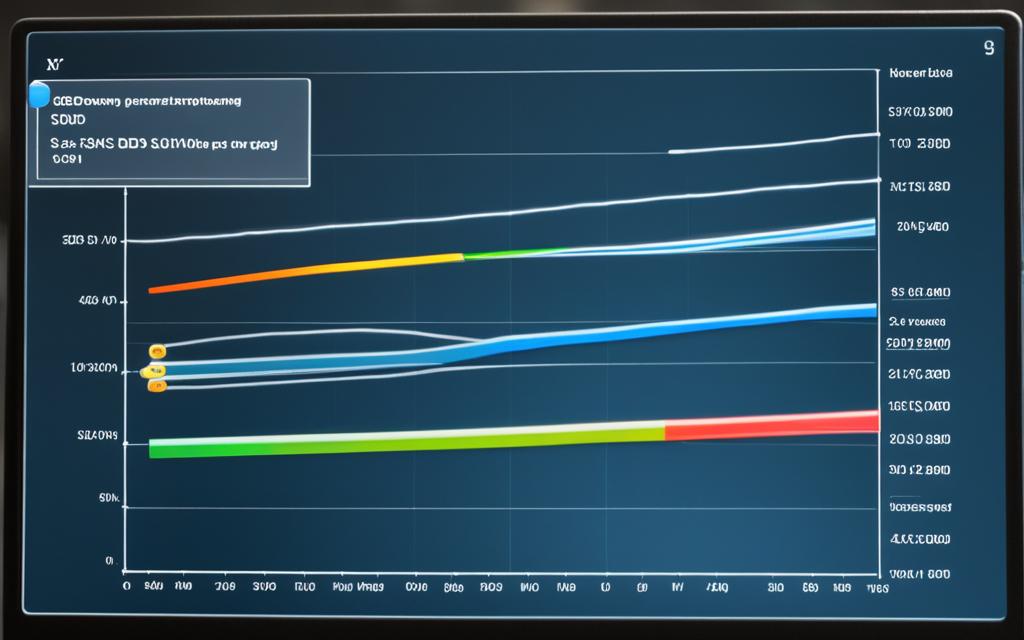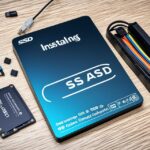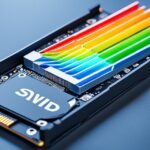Table of Contents
In our digital age, solid-state drives (SSDs) shine as the top choice for storage, beating old-school hard drives. But, have you noticed? When SSDs get really full, they start to lag. It’s important to grasp why this happens to keep them speedy. Experts have found that SSDs begin to lose speed when they’re about 75% full. The slowdown gets worse after 90%, suggesting we need to manage space wisely12. Let’s explore SSD technology, how full disks affect them, and how to keep them running smoothly.
Key Takeaways
- SSDs can experience a slowdown as they fill up.
- It’s advisable to utilize only about 75% of an SSD’s capacity for optimal performance.
- Leave at least 10% of drive space empty to prevent slowdowns.
- Overprovisioning SSD space plays a vital role in maintaining consistent performance.
- Performance metrics show substantial improvements when SSDs have about 25% spare area.
The Impact of Full Capacity on SSD Performance
Understanding SSD technology can greatly affect performance as storage fills up. SSDs use flash memory for quicker access than traditional drives. However, this speed advantage reduces when the SSD gets full. So, keeping enough free space is crucial for the best function.
Understanding SSD Technology
The idea of write amplification is key to SSD performance. It means data writing becomes less efficient as the SSD gets fuller. Managing write amplification well is important. A high Write Amplification Factor (WAF) means much more data is written than needed. This can slow down the SSD3.
How Capacity Influences Speed
When an SSD is over 75% full, it starts to slow down. This affects tasks like starting the computer or opening apps4. It’s wise to keep at least 20% of the SSD empty5. This space helps the SSD write data efficiently, keeping it reliable and long-lasting.
| SSD Performance Metric | Recommended Level |
|---|---|
| Free Space | 20% – 30% |
| Write Amplification Factor (WAF) | Close to 1 |
| Optimal Used Space | Below 75% |
Identifying Slowdown Symptoms in SSDs
As SSDs become crucial for managing data, it’s important to spot SSD slowdown symptoms early. Many indicators warn us about potential problems with these drives.
Performance Metrics to Observe
Watching the read and write speeds is key. Write speeds might drop 40-50% when the drive is nearly full, especially over 70% capacity6. This can cause slow file transfers and longer app loading times. It shows the drive’s performance is dropping. SSDs usually show such issues around 14.2 months old, showing that even newer devices can slow down with high use6.
Typical User Experiences
Users report many signs when their SSD slows down. Issues like failing to read or write files, leading to read-only errors. Also, frequent crashes during startup can mean the SSD is failing6. Very slow performance often points to SSD faults. For instance, a 5-year-old 1TB SSD took over 42 hours for a backup, showing the effects of slowness from capacitive charge loss7. Regular checks and maintenance are vital for keeping SSDs running well.
| Issue | Potential Impact | Indicator |
|---|---|---|
| Bad block errors | Data loss, corruption | Frequent read errors |
| Read/write failures | Read-only errors | Inability to access files |
| System crashes | Loss of productivity | Crashing during startup |
| Sluggish performance | Decreased efficiency | Long loading times |
Spotting SSD slowdown symptoms early really helps improve the user experience and extends the drive’s life. Keeping an eye on these indicators and acting quickly is key.
Does SSD Slow Down When Full?
When SSDs get close to their full capacity, their performance may drop. This is especially true for performance under full capacity. When used space goes over 75%, SSDs find it hard to keep up. Write speeds can fall a lot, causing delays. Users might see these issues during gaming or starting applications4. It’s important to keep an eye on these signs.
Performance Under Full Capacity
If an SSD is almost full, write speeds could slow down by 40%-50%8. Handling data gets complicated, slowing down new data storage. Many report their PCs lagging during heavy tasks. This problem is linked to how full the SSD is4.
Write Amplification and Its Effects
Write amplification plays a big role in SSDs slowing down when full. It happens because data needs reshuffling to make room for new files. This process slows things down. But, using TRIM and clearing space helps manage this better4. Write caching can also quicken data transfers. However, it carries the risk of data loss if the power cuts out8.
| Aspect | Impact When Full | Recommended Solutions |
|---|---|---|
| Write Speed | 40%-50% slower than standard speeds8 | Free up disk space, run Disk Cleanup4 |
| System Performance | PCs may slow down or freeze during operation4 | Ensure TRIM is enabled, optimise space4 |
| Data Management | Increased complexity leading to SSD slowdown | Use write caching for boosted speed8 |
Best Practices to Maintain SSD Performance
To get the best out of your SSD, adopting good maintenance strategies is key. Two main actions are enhancing storage efficiency and using TRIM with write caching.
Optimising Storage Space
Not filling your SSD to the brim is vital to avoid slowing it down. About 84% of users find their SSDs lag when nearly full9. Moving large files you rarely use to HDDs preserves SSD space for more important data10. Turning off hibernation saves a lot of space, equal to your computer’s RAM. This boosts both speed and lifespan9.
Enabling TRIM and Write Caching
Turning on TRIM is crucial. It tells your SSD which data blocks aren’t needed, enhancing storage efficiency and extending durability10. It’s a big help in keeping your SSD in top shape, especially when writing data9. Write caching also speeds things up but watch out for data loss if power goes out10. Keep your SSD’s firmware up to date to fix bugs and maintain performance.
| Practice | Benefit |
|---|---|
| Optimising Storage Space | Prevents performance issues by avoiding full capacity |
| Enabling TRIM | Maximises lifespan and efficiency of SSDs |
| Enabling Write Caching | Significantly enhances speed and performance |
| Disabling Hibernation | Reduces disk writes and saves space |
| Updating Firmware | Maintains performance and prevents bugs |
Conclusion
Solid-state drives (SSDs) tend to slow down as they fill up. This slowdown can really impact users who need fast performance. It’s crucial to know how SSDs work and to spot when they’re getting slower11 by looking at how well they perform12.
To avoid problems, it’s important to keep your SSD in good shape. Doing things like cleaning up files, using the TRIM command, and setting aside extra space can help a lot. This way, your SSD will work better for longer, even as you add more files to it.
Research shows that many SSDs start to slow down after you use them a lot. Some can lose up to 64% of their speed, even if you let them rest. But one, the Western Digital Black SN850X, stays fast. Checking these details helps people pick SSDs that won’t disappoint11. If you want more info, this link goes into it more.
FAQ
Do SSDs slow down when they reach full capacity?
Yes, SSDs can slow down as they fill up. This happens because managing the little remaining space gets complex.
What is write amplification and how does it affect SSD performance?
Write amplification means an SSD has to shuffle existing data to store new information. This can make writing new data slower, reducing overall performance.
At what capacity do users start to notice a decrease in SSD performance?
Users might see slower speeds and longer load times when their SSD is about 70% full.
What are common symptoms of SSD slowdown?
Slower speeds, longer application load times, and stuttering in high-demand activities are signs. These can happen in tasks like gaming or editing videos.
How can I optimise my SSD’s performance?
Keep your SSD fast by removing files you don’t need. Also, use TRIM and write caching to manage data better.
What should I do if my SSD is running slow?
If your SSD is slow, try freeing up space. Also, make sure TRIM is on and keep your data organised.
Can I recover speed after my SSD slows down?
You can get some speed back by managing storage and enabling TRIM. However, if it’s full, it might not get completely fast again without clearing space.
Source Links
- https://www.howtogeek.com/165542/why-solid-state-drives-slow-down-as-you-fill-them-up/ – Why Solid-State Drives Slow Down As You Fill Them Up
- https://www.overclock.net/threads/do-all-ssd-solid-state-drives-slow-down-after-the-get-50-full.1535492/ – do all ssd solid state drives slow down after the get…
- https://condusiv.com/do-ssds-degrade-over-time/ – Do SSDs Degrade Over Time?
- https://www.partitionwizard.com/resizepartition/do-ssd-slow-down-when-full.html – Do SSD Slow Down When Full & How to Fix It? [Answered]
- https://datarecovery.com/rd/slow-performance-on-an-ssd-6-common-causes/ – Slow Performance on an SSD: 6 Common Causes – Datarecovery.com
- https://www.szyunze.com/identifying-ssd-warning-signs-and-solutions-what-we-know/ – Identifying SSD Warning Signs and Solutions: What We Know
- https://thegearforum.com/threads/ssd-slowness-over-time-i-learned-my-lesson-re-charging-memory-cells.4677/ – SSD slowness over time – I learned my lesson – re-charging memory cells
- https://www.easeus.com/partition-manager-software/does-ssd-get-slower-when-full.html – Does SSD Get Slower When Full? Fix SSD Slowing Down [Easy Tricks]
- https://www.diskpart.com/articles/ssd-slowing-down-7201.html – SSD Slowing Down? 7 Quick Tricks to Make SSD Run Faster!
- https://www.easeus.com/partition-manager-software/ssd-maintenance.html – SSD Maintenance: Tips to Maintain Performance and Extend the Life of Your SSD
- https://www.kingston.com/en/blog/pc-performance/benefits-of-ssd – The 5 Benefits of SSDs over Hard Drives- Kingston Technology
- https://www.compuram.de/blog/en/the-life-span-of-a-ssd-how-long-does-it-last-and-what-can-be-done-to-take-care/ – The life span of an SSD – how long does it last and what can be done to take care?












